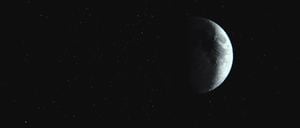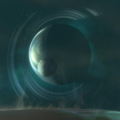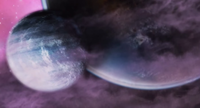Natural satellite: Difference between revisions
From Halopedia, the Halo wiki
BaconShelf (talk | contribs) m (Reverted edits by 121.7.109.37 (talk) to last revision by SpyglassUnitBeta) Tag: Rollback |
m (Text replacement - "{{[Ee]ra\|[^}\n]*(Forerunner|Covenant|Human|UNSC|HCW|Post)[^}\n]*}}" to "{{Status|Canon}}") |
||
| Line 1: | Line 1: | ||
{{ | {{Status|Canon}} | ||
{{Wikipedia}} | {{Wikipedia}} | ||
{{Center|''Looking for [[Earth]]'s moon, [[Luna]], or [[Moons (game)|moons]], the pool variant?''}} | {{Center|''Looking for [[Earth]]'s moon, [[Luna]], or [[Moons (game)|moons]], the pool variant?''}} | ||
Revision as of 17:43, March 19, 2022
| There is more information available on this subject at Natural satellite on the English Wikipedia. |
A natural satellite, referred to as a satellite[1][2][3] or moon,[4][5] is a celestial body that orbits a planet or smaller body, which is referred to as a "gravity anchor".[4] Moons vary widely in size, surface features, or atmosphere.
Overview
Some natural satellites were only asteroids captured by a planet's orbit, such as Reach's smaller moon Turul.[6] Other moons are the size of planets, such as Basis which is nearly twice the size of Earth.[7]
There are a number of planets that have extensive systems of moons, like Threshold and its 12 satellites,[5] or Vitalyevna and its 27 moons.[8]
List of known moons
- Main article: [[:
- Category:Moons|
- Category:Moons]]
Gallery

|
Browse more images in this article's gallery page. |
Csodaszarvas and Turul, the two natural satellites of Reach.
Sources
- ^ Halo Waypoint, Universe - Earth (Retrieved on Jun 1, 2020) [archive]
- ^ Halo Waypoint, Universe - Alluvion (Retrieved on Jun 1, 2020) [archive]
- ^ Halo Waypoint, Universe - Mars (Retrieved on Jun 1, 2020) [archive]
- ^ a b Halo Waypoint, Universe - Meridian (Retrieved on Jun 1, 2020) [archive]
- ^ a b Halo Waypoint, Universe - Threshold (Retrieved on Jun 1, 2020) [archive]
- ^ halo.bungie.org, I've got your answer, Levi... (Retrieved on Jun 1, 2020) [archive]
- ^ halo.bungie.org, Halo-verse Planetary Scale (Retrieved on Jun 1, 2020) [archive]
- ^ Halo Waypoint, Universe - Locations - Page 2 (Retrieved on Jun 1, 2020) [archive]



